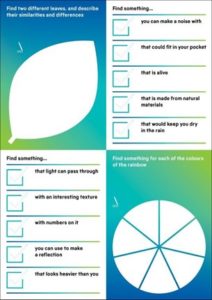Find something you could use to count with. Find something that light can pass through. Find something that makes you happy. These are the kind of challenges that you can expect to see in a Science Museum Group Object Hunt trail.

The aim of all our trails is to inspire and support self-led experiences around our museums and beyond. They capitalise on the first-hand experiences of being surrounded by, and in front of, real objects and everyday things. They offer quick, simple and easy to understand challenges and are designed to be used either by small groups of school children or by families.
Our trails, like all of our resources, are founded on evidence-based audience and academic research to help visitors feel welcome and confident to explore our spaces and content themes, giving them choice and control over their experience and inspiring them to find out more.
Why did we create ‘Great Object Hunts’?
We originally created our Great Object Hunts to help people to feel more confident to explore our museum galleries. A visit to a museum can feel overwhelming with 1,000s of objects on display, it can be really hard to know where to start.
They are self-led trails which use open questions to allow visitors to choose their own paths and follow their own interests. There are no ‘correct answers’ to any of the challenges. It is down to the visitors to seek out something that they believe fits.
What are the features of a Great Object Hunt?

The trails are developed around broad content themes that allow for a wide range of options for answers. They have been created so that they don’t take longer than 30mins to complete, as our research has found this is the average time visitors would want to spend on a trail.
Great Object Hunts use two types of challenges: tick box ‘seek and find’ challenges, and feature challenges using themed shapes to which responses are added.
Choosing Great Object Hunt themes
Our trails are framed around our museums’ STEM content themes and invite people to add their own challenges. We have developed a range of hunts that follow various topics including Maths, Design and Engineering, Health, and Materials, as well as a more generic one for each site called Explorer. Some trails have a curriculum focused theme which may appeal more to schools, but they are not developed exclusively for them.
How does the physical format of the hunts help people use them?
We are constantly reflecting on our resources and trying to make them as accessible as possible. We have recently redesigned our hunts in order to achieve this.
There are two main formats of the Great Object Hunts:
- A physical, full colour, printed version that is distributed in the museum
- An online downloadable, self-printed PDF version (a double-sided A4 page that is folded twice to make an A6 booklet) which was designed to use minimal paper and ink consumables.
Can’t get to a museum to try one out? Never fear….
Our ‘Out and About’ Object Hunt was developed to encourage people to explore at home, at school or in their own local area. This helps to extend the experience beyond just a museum visit and helps to reach wider audiences. It includes challenges such as finding something with an interesting pattern, something that would fit in your pocket and something that would keep you dry in the rain. We hope it helps bring the museum experience into everyday life, helping promote science talk and helping people recognise how science, technology, engineering and maths fits into their everyday lives.
All our learning resources, including our Great Object Hunts, are developed with our audiences needs at their heart, using our engagement reflection points.
They are free to download on our Learning Resources website. If you use one of our Out and About Great Object Hunts please let us know what you think via @LearningSMG.